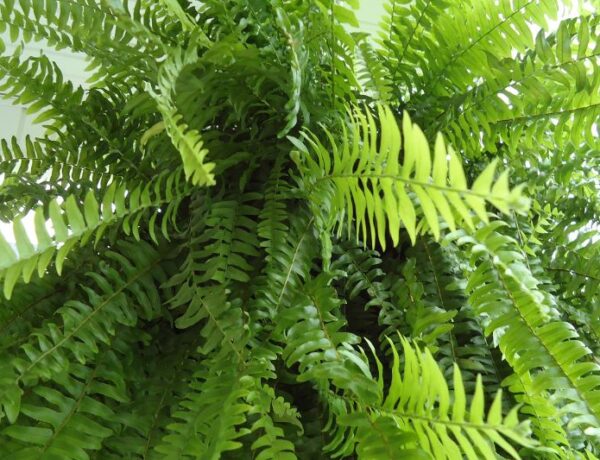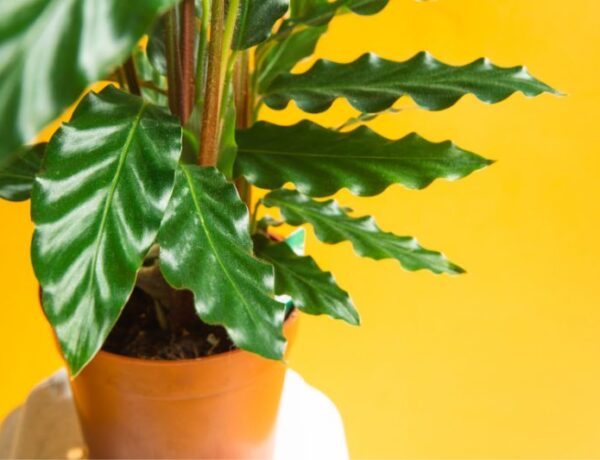Fiddle Leaf Fig, the leafy diva that’s captured the hearts of interior designers and Instagrammers alike.
Spoiler alert: caring for this plant isn’t as tricky as you might think. With a few tips and a sprinkle of love, your Fiddle Leaf Fig will not just survive; it’ll thrive. So, if you’ve been contemplating adding this gorgeous green to your living space, or if you’ve already got one and are keen to keep it happy, you’re in the right place.
Stick with me, and we’ll turn you into a Fiddle Leaf Fig whisperer in no time!
Table of Contents
1. General Information & Taxonomy
| Scientific name: | Ficus lyrata |
| Common names: | Fiddle Leaf Fig, FLF |
| Native to: | Western Africa |
| Toxicity: | Toxic to pets |
| Mature size: | Up to 10 feet indoors |
| Category: | Indoor/Outdoor Plant |
| Growth Rate: | Moderate |
| Hardiness: | USDA Zones 10-12 |

2. Fiddle Leaf Fig Care & Growing Requirements
» Watering
When it comes to watering your Fiddle Leaf Fig, consistency is key. Wait until the top inch of soil is dry to the touch, then give it a good soak until water drains out the bottom of the pot.
No swampy soil, please! Overwatering can lead to root rot. During the winter, when the plant is less active, cut back on watering.
» Light
Fiddle Leaf Fig plant loves the spotlight—literally! Aim for a spot near a bright, but not direct, window. East or west-facing windows are typically best. Too much direct sun can scorch those leaves, while too little light can stunt growth and cause those leaves to lose their vibrant green hue.
🌱 Quick Tip: Think of your Fiddle Leaf Fig as a skincare enthusiast—introduce it to the sun gradually to avoid the leafy equivalent of a sunburn!
» Soil
While there’s a lot of specific advice on Fiddle Leaf Fig soil, the real MVP is good drainage. Sure, a 2:1 mix of peat and perlite is a safe bet, but don’t sweat it—you’ve got options. Feel like experimenting? Orchid bark, coconut coir, or a dash of gravel can also make your mix well-draining.
🌱 Quick Tip: The goal here isn’t a perfect recipe; it’s soil that lets water move freely to keep those roots happy and rot-free.
» Temperature
Your Fiddle Leaf Fig is a warm-weather fan. Keep room temps between 65-75°F (18-24°C). Avoid spots where the temperature dips below 50°F (10°C), as that’s a cold shoulder this plant won’t appreciate.
» Humidity
This plant loves moisture in the air, aiming for a humidity level of 40-50%. If your home is on the dry side, a humidifier can help. Just don’t overdo it to avoid attracting pests.
» Fertilizer
If you’re focused on lush, green foliage—let’s be honest, who isn’t?—then opt for a fertilizer with an NPK ratio of 3-1-2. This formula is tailored to promote vibrant leaf growth and overall plant vitality.
Aim to fertilize every 4-6 weeks during the active growing season, which is from spring to early fall. Always follow the package instructions for dilution and application rates. And don’t forget: winter is your plant’s downtime, so give it a break and skip the fertilization during the colder months.
3. Fiddle Leaf Fig Maintenance and Propagation
» Repotting
Aim to repot your Fiddle Lead Fig every 18-24 months, usually in the spring. Choose a pot that’s 2-3 inches larger in diameter than the current one, ensuring it has good drainage.
Carefully lift your plant, place it in the new pot, and fill around it with fresh, well-draining soil. This gives your plant room to grow and refreshes its soil environment.
» Pruning
If your Fiddle Leaf Fig is looking a bit wild or has some damaged leaves, it might be time for a little haircut.
Using clean, sharp scissors, trim off any dead or yellow leaves and any overly long branches. This will help direct energy to new growth and maintain a pleasing shape.
Just be careful not to remove more than 10-15% of the total leaf area at once, as you don’t want to stress the plant.
» Propagation
Cut a leaf or a stem segment that’s about 4-6 inches long, making sure it has at least one leaf attached. Let the cutting sit out for an hour to form a callus on the cut end. Then, place it in a jar of water or directly into soil. Keep it in a warm, bright place but out of direct sunlight.
In a few weeks, you should start to see roots forming. Once they’re a couple of inches long, plant your new baby Fiddle Leaf Fig in its pot and watch it grow!
4. Common Issues
Even the most pampered Fiddle Leaf Figs can face a few challenges. Let’s tackle some of the common issues you might encounter:
- Brown Spots: Often a sign of overwatering or insufficient drainage. Dial back on the H2O and ensure your pot has proper drainage holes.
- Yellow Leaves: Usually an indicator of underwatering or low humidity. Check your watering routine and consider boosting humidity levels.
- Drooping Leaves: If your plant looks a little sad and droopy, it might need more light. Move it to a brighter location but avoid direct sunlight.
- Leaf Loss: Sudden leaf loss can be alarming. It might be due to sudden temperature changes or drafts. Keep your plant in a stable environment.
- Transplant Shock: Noticed your plant looking stressed after repotting? This is known as transplant shock. Keep the soil moist and avoid direct sunlight until the plant acclimates to its new home.
5. Fiddle Leaf Fig Diseases & Pests
While your Fiddle Leaf Fig is relatively hardy, it’s not entirely immune to diseases and pests.
Root rot is the most common disease, usually a result of overwatering and poor drainage. On the pest side, spider mites, aphids, and mealybugs can sometimes be unwelcome visitors.
If you notice any suspicious signs—like webbing or tiny bugs—act quickly. A treatment with insecticidal soap or neem oil can usually nip the problem in the bud.
Conclusion
If you’ve enjoyed learning about the Fiddle Leaf Fig, you might also be interested in expanding your indoor jungle with some other fabulous options. Check out our guides on large leaf houseplants and tall indoor plants for more inspiration.
Remember, every plant has its quirks, but with a bit of love and the right care, your Fiddle Leaf Fig will be more than just a pretty face—it’ll be a thriving member of your home. So, grab that watering can and let’s make your Fiddle Leaf Fig the star it was born to be!






No Comments